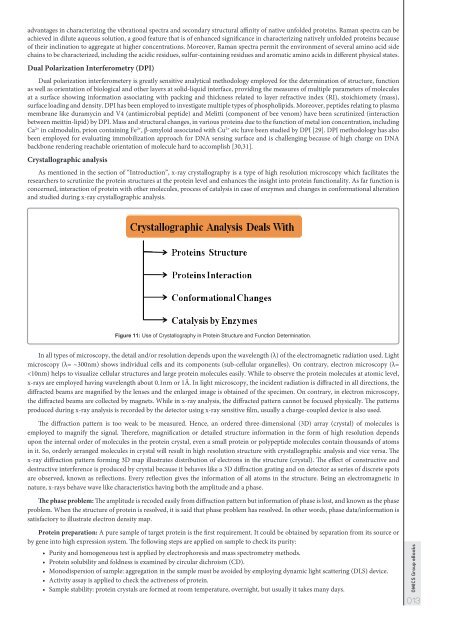You also want an ePaper? Increase the reach of your titles
YUMPU automatically turns print PDFs into web optimized ePapers that Google loves.
advantages <strong>in</strong> characteriz<strong>in</strong>g the vibrational spectra and secondary structural aff<strong>in</strong>ity of native unfolded prote<strong>in</strong>s. Raman spectra can be<br />
achieved <strong>in</strong> dilute aqueous solution, a good feature that is of enhanced significance <strong>in</strong> characteriz<strong>in</strong>g natively unfolded prote<strong>in</strong>s because<br />
of their <strong>in</strong>cl<strong>in</strong>ation to aggregate at higher concentrations. Moreover, Raman spectra permit the environment of several am<strong>in</strong>o acid side<br />
cha<strong>in</strong>s to be characterized, <strong>in</strong>clud<strong>in</strong>g the acidic residues, sulfur-conta<strong>in</strong><strong>in</strong>g residues and aromatic am<strong>in</strong>o acids <strong>in</strong> different physical states.<br />
Dual Polarization Interferometry (DPI)<br />
Dual polarization <strong>in</strong>terferometery is greatly sensitive analytical methodology employed for the determ<strong>in</strong>ation of structure, function<br />
as well as orientation of biological and other layers at solid-liquid <strong>in</strong>terface, provid<strong>in</strong>g the measures of multiple parameters of molecules<br />
at a surface show<strong>in</strong>g <strong>in</strong>formation associat<strong>in</strong>g with pack<strong>in</strong>g and thickness related to layer refractive <strong>in</strong>dex (RI), stoichiomety (mass),<br />
surface load<strong>in</strong>g and density. DPI has been employed to <strong>in</strong>vestigate multiple types of phospholipids. Moreover, peptides relat<strong>in</strong>g to plasma<br />
membrane like duramyc<strong>in</strong> and V4 (antimicrobial peptide) and Melitti (component of bee venom) have been scrut<strong>in</strong>ized (<strong>in</strong>teraction<br />
between meitt<strong>in</strong>-lipid) by DPI. Mass and structural changes, <strong>in</strong> various prote<strong>in</strong>s due to the function of metal ion concentration, <strong>in</strong>clud<strong>in</strong>g<br />
Ca 2+ <strong>in</strong> calmodul<strong>in</strong>, prion conta<strong>in</strong><strong>in</strong>g Fe 2+ , β-amyloid associated with Cu 2+ etc have been studied by DPI [29]. DPI methodology has also<br />
been employed for evaluat<strong>in</strong>g immobilization approach for DNA sens<strong>in</strong>g surface and is challeng<strong>in</strong>g because of high charge on DNA<br />
backbone render<strong>in</strong>g reachable orientation of molecule hard to accomplish [30,31].<br />
Crystallographic analysis<br />
As mentioned <strong>in</strong> the section of “Introduction”, x-ray crystallography is a type of high resolution microscopy which facilitates the<br />
researchers to scrut<strong>in</strong>ize the prote<strong>in</strong> structures at the prote<strong>in</strong> level and enhances the <strong>in</strong>sight <strong>in</strong>to prote<strong>in</strong> functionality. As far function is<br />
concerned, <strong>in</strong>teraction of prote<strong>in</strong> with other molecules, process of catalysis <strong>in</strong> case of enzymes and changes <strong>in</strong> conformational alteration<br />
and studied dur<strong>in</strong>g x-ray crystallographic analysis.<br />
Figure 11: Use of Crystallography <strong>in</strong> Prote<strong>in</strong> Structure and Function Determ<strong>in</strong>ation.<br />
In all types of microscopy, the detail and/or resolution depends upon the wavelength (λ) of the electromagnetic radiation used. Light<br />
microscopy (λ= ~300nm) shows <strong>in</strong>dividual cells and its components (sub-cellular organelles). On contrary, electron microscopy (λ=<br />



